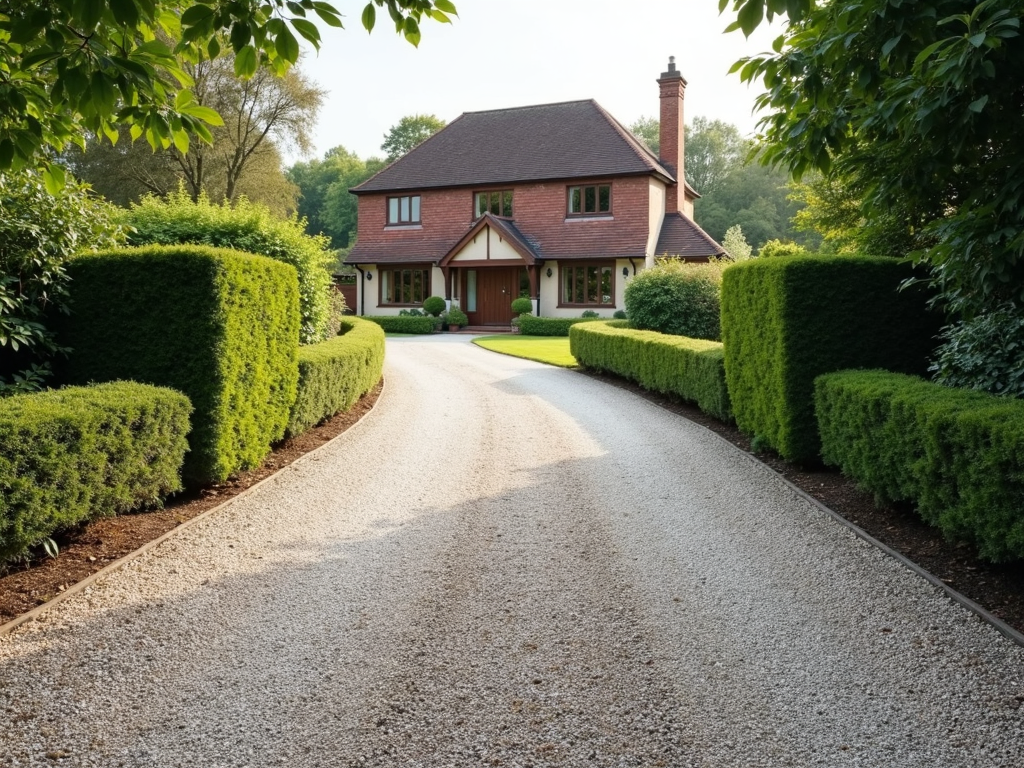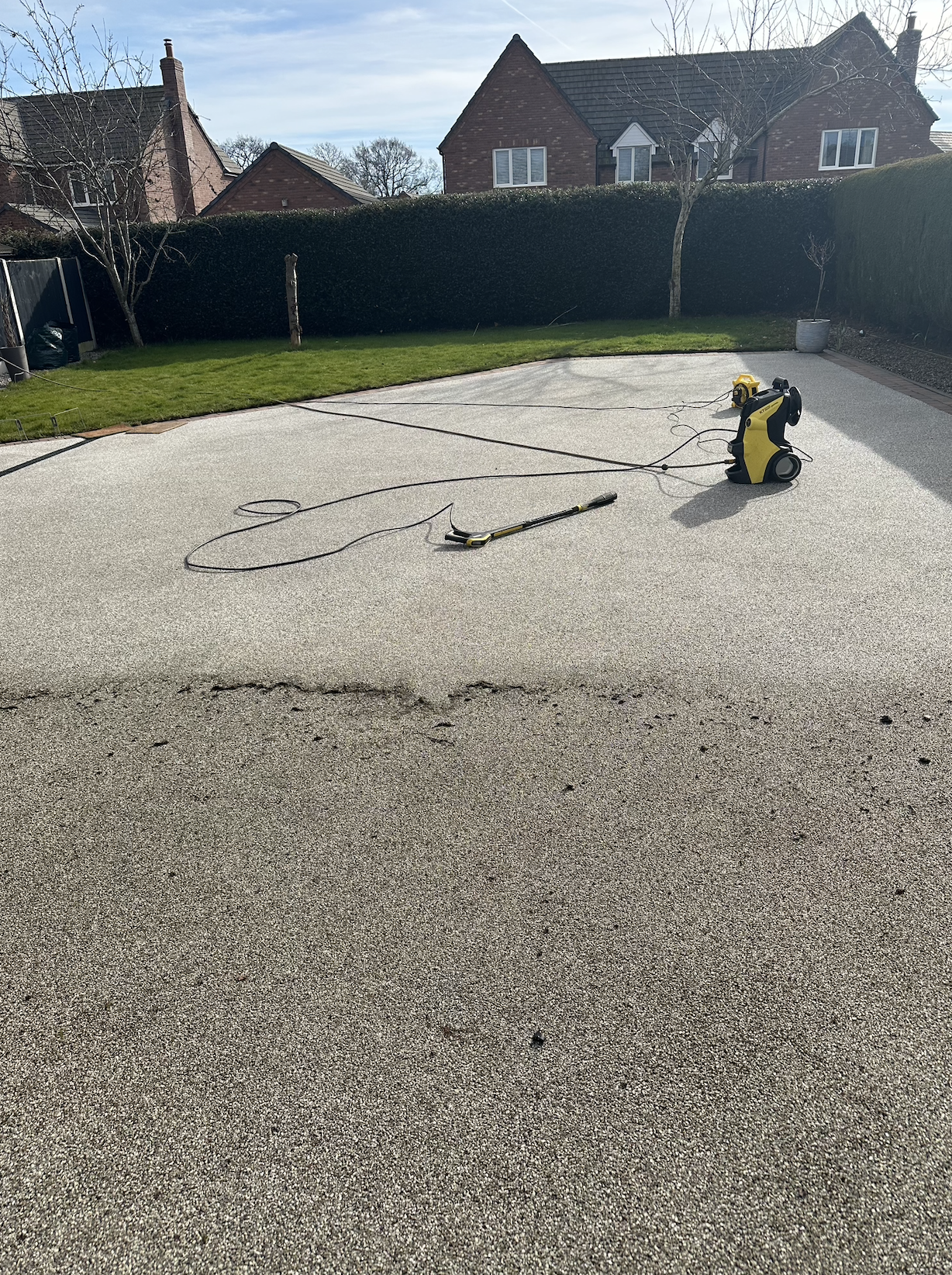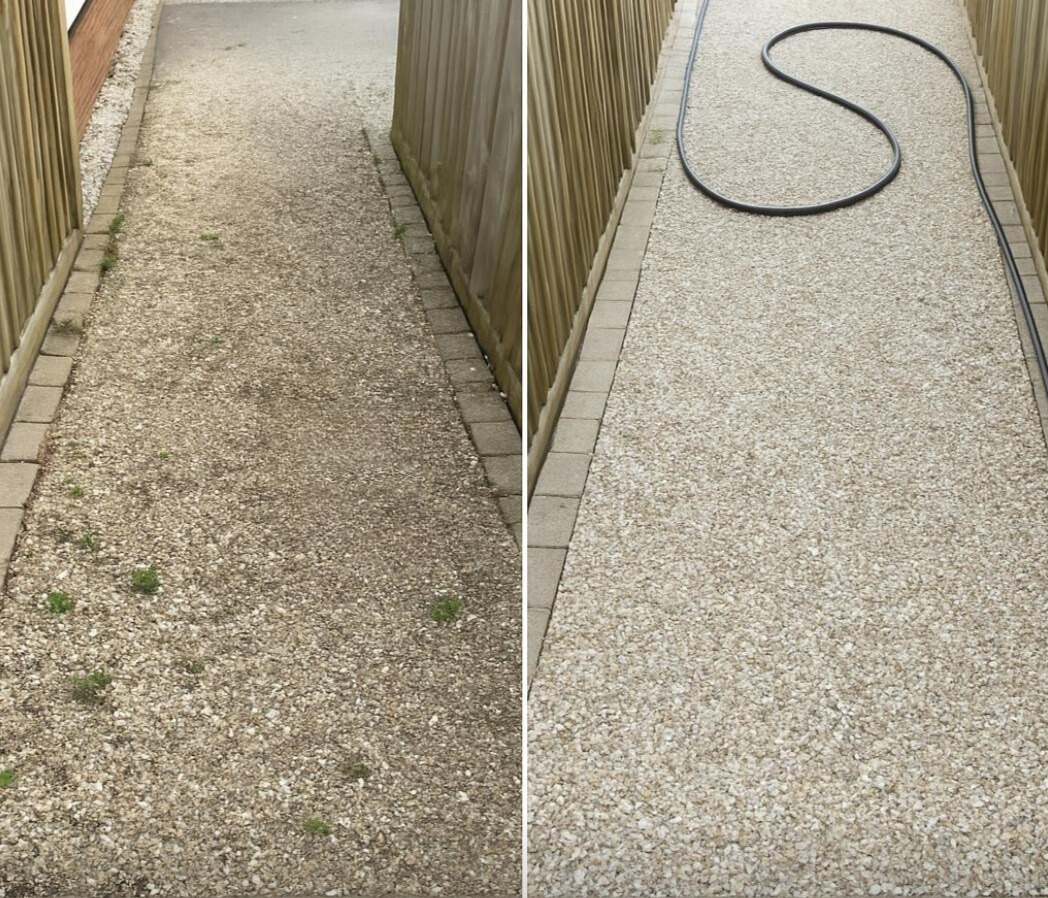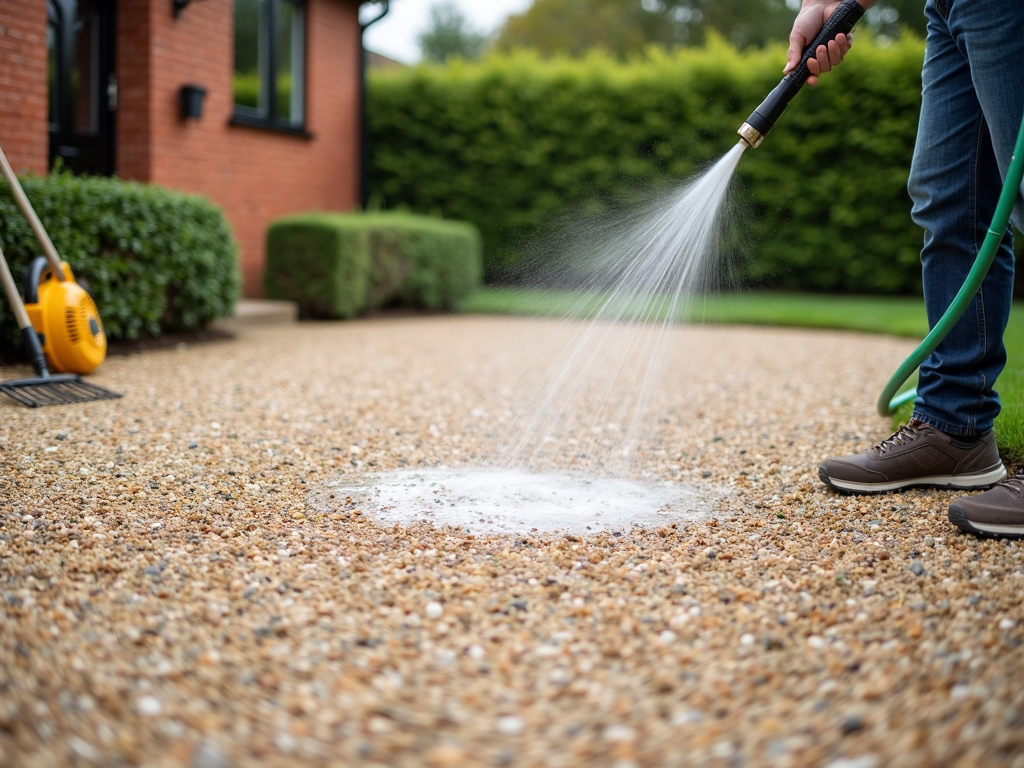
Overview
A clean gravel driveway boosts both kerb appeal and practicality, whether you’re welcoming guests or simply enjoying your home. It sets the tone for your outdoor space and helps everything look a bit more put together. Over time, though, weather, foot traffic and vehicles can leave gravel driveways looking tired or uneven, so regular upkeep is essential.
At Luxe Gardens, we often work with homeowners who want to keep their driveways looking sharp without losing that natural, rustic feel. In areas like Shropshire—where gravel driveways are a common sight thanks to the mix of countryside charm and practical living—knowing how to clean and care for them properly can make all the difference.
Keeping your gravel driveway clean isn’t just about looks – it’s about safety and longevity. Using the right techniques and tools will prevent you from displacing stones, damaging the surface or compacting the gravel incorrectly. Ensuring proper maintenance helps protect both the safety and longevity of your gravel area. This will maintain the look of your driveway and avoid costly repairs. At Luxe Gardens, we know from experience that regular upkeep makes all the difference when it comes to avoiding costly repairs and keeping your outdoor space looking its best.
A gravel area or driveway is a top choice for many homeowners because they’re affordable, rustic and low maintenance compared to paved alternatives. But “low maintenance” doesn’t mean “no maintenance”. Without regular cleaning and care, even the sturdiest gravel driveway can become unsightly or unsafe.
Effective maintenance involves several key steps: clearing leaves, twigs and trash; controlling weed growth before it takes over; and tackling stubborn stains from oil or organic matter. These tasks done regularly will keep it looking neat and will retain the gravel’s structure and cleanliness.
More importantly, regular cleaning will prevent long-term issues like potholes, washouts and rutting. These can compromise both the look and usability of the driveway. Depending on the condition of your gravel driveway, you might need to take extra steps to address specific problems. By staying ahead of them with simple maintenance practices, you can extend the life of your gravel driveway and avoid major repairs.
Preparing for Cleaning
Before you start cleaning your gravel driveway, make sure you have all the necessary tools and materials. Before you begin, gather all necessary tools and materials. We recommend having a large push broom, a leaf blower, gloves, and a garden hose with a spray nozzle at hand. These tools will streamline the process and minimise disruption. If you’re going to tackle tough stains, you may also want to have a rake, weed removal tools and a safe cleaning solution.
The first step in preparing your gravel driveway is to clear away any visible weeds, debris and organic matter. Over time, leaves, sticks and even trash can accumulate on the surface and between gravel stones. Clearing this clutter makes it easier to spot problem areas and sets the stage for a deeper clean. Pull out any visible weeds by hand or with a weeding tool to prevent them from spreading deeper into the gravel bed. For stubborn clusters of weeds or plant material that are difficult to remove, you may need to use targeted weed killers or spend extra time manually pulling them out.
Next, use a leaf blower or a large outdoor broom to sweep or blow away bigger debris. This step is key to having a clean working surface so you can focus on the deeper cleaning later without interruptions from surface clutter. Be especially careful when cleaning around delicate stone types, as aggressive sweeping or blowing can damage their appearance or integrity. A leaf blower is great for big areas, a broom gives you more control in tight spots or corners.
Safety first when working outside. Wear protective gear like gardening gloves to protect your hands from sharp gravel and debris, and eye protection to protect against dust or small stones that may get kicked up during cleaning. Especially if you’re using a leaf blower or handling any type of chemical cleaner.
Finally, consider the environment. Choose eco-friendly cleaning solutions that are biodegradable and safe for nearby plants and wildlife. Not only are these products kinder to your driveway, but they also keep your outdoor space healthy. Being environmentally conscious while taking care of your property is a win-win for your home and the planet.
Removing Debris
The first step is to clear the surface debris like leaves, twigs, general litter, and decomposing plant material. These tend to accumulate quickly, especially during windy or stormy weather. Use a big outdoor broom or a leaf blower to sweep or blow the loose material off the gravel. This will not only make the driveway look better but also prepare it for a deeper clean.
Make sure to remove any larger debris like fallen branches, big rocks or other bulky items that could get in the way of the cleaning process. Leaving these in place can damage your gravel surface or your cleaning tools. Best to clear them manually before you start, especially if you’re using powered equipment or tools that could be obstructed or damaged by larger obstacles.
For a deeper clean, you can use a metal mesh or sieve to help separate the fine dirt, sand and organic material from the gravel itself. This is especially useful if your driveway has accumulated a lot of silt or grime over time. Just scoop small amounts of gravel and shake the mesh to allow the finer particles to fall through, and then return the cleaned gravel to the driveway. This will keep the gravel layer consistent and clean without losing too much material in the process.
Removing debris consistently is not just for show – it’s crucial for long-term driveway health. Organic matter and dirt can create the perfect conditions for weeds and moss to grow and make the surface uneven. By removing debris regularly, you’re maintaining the structure of the driveway, discouraging unwanted plant growth and minimising the need for deep cleans or gravel replenishment.
For tough or stuck-on grime, a pressure washer can be a great addition to your cleaning arsenal. Use it on a low-pressure setting so you don’t disturb the gravel or push stones out of place. The gentle force of the water lifts embedded dirt and rinses away fine debris without damaging the surface. This is especially useful after long periods of buildup or bad weather.

Loosening the Gravel
Start by using a large outdoor broom or a leaf blower on low power to gently loosen the top layer of gravel. This lifts and dislodges embedded dirt, small stones and other debris that has settled over time. By disturbing the surface slightly, you make it easier to get to and clean the layers underneath without having to dig or disrupt the structure too much.
Loosening the gravel is an important step that prepares the surface for more intense cleaning. When the gravel is loosened, water and cleaning agents can penetrate more easily, and you can wash away grime and organic buildup more thoroughly. It also reduces the risk of damage if you apply cleaning methods directly to a compacted surface.
But be careful during this process. Over loosening or blowing away too much gravel can create uneven areas, potholes or ridges in your driveway. If too much material is displaced, you may have to redistribute it manually or even add more gravel to get it back to even, adding extra work and cost.
An alternative or additional method is to use a garden hose with a gentle spray attachment. This allows you to lightly mist the gravel, which will loosen compacted dirt and dust without shifting the stones too much. This is especially useful during warmer months when the ground is dry and more prone to dust accumulation.
In some parts of Shropshire, where heavier soils are more common, moisture can linger and lead to compaction over time. Loosening the gravel now and then makes ongoing maintenance much easier.
Power Washing
Power washing can be a great way to deep clean a gravel driveway when dealing with tough dirt, stains, dirt and stains, or compacted grime. But you have to be careful. Gravel is loose and can be displaced easily so improper use of a pressure washer can turn a helpful tool into a source of damage.
Always use a pressure washer on a low pressure when cleaning gravel. High pressure can scatter stones, erode the base layer and create uneven patches or bare spots. Low pressure is strong enough to loosen dirt and organic matter but gentle enough to preserve the structure of your driveway and not create safety hazards.
Keep a safe and consistent distance between the pressure washer nozzle and the gravel surface. Holding the wand too close can push gravel out of place or embed water too deep into the base layer, which can lead to long-term stability issues. Keeping at least a foot above the surface and moving in smooth sweeping motions will ensure even cleaning without disturbing the layout.
In smaller areas or with more delicate types of gravel, consider using a garden hose with a gentle spray attachment instead of a power washer. This will give you more control and less force, perfect for spot cleaning or maintaining driveways that can’t even tolerate low-pressure washing.
At Luxe Gardens, we only use power washing when it’s really necessary—and always with extra care. It’s not a method we overuse, because we know that preserving the structure of the driveway is just as important as getting it clean.
While power washing can remove embedded dirt and ugly stains, it’s just one method among many when learning how to clean a gravel driveway effectively. Overuse can lead to gradual erosion of the driveway or displacement of gravel over time. Use this method sparingly – only when necessary – to keep your gravel driveway looking fresh without compromising its structure.
Cleaning Solution Application
To clean dirt, grime and surface stains on your gravel driveway, you can apply a cleaning solution directly to the affected areas. Mild options like white vinegar or diluted dish soap work well for general cleaning and are safe for most gravel types. These solutions break down organic matter and lift stains without the need for scrubbing or harsh chemicals.
For more intense cleaning, use a small stiff bristle brush to gently scrub the treated areas. Be careful not to disturb the gravel while doing so. Using controlled circular motions helps lift stains from the surface of individual stones without displacing them, so you don’t have to re-level the driveway afterwards.
When cleaning stains, focus on small localised areas rather than the entire surface—this targeted approach is a smart way to master how to clean a gravel driveway without overdoing it. Spot cleaning saves time and resources and reduces the risk of overexposing your gravel to cleaners. Never use harsh chemicals like bleach or ammonia as they can degrade certain types of gravel, kill nearby plants, or harm pets and wildlife.
If you have decorative or light colored stones like marble chips, consider using baking soda to clean and brighten them. Baking soda is gentle yet effective at lifting stains and restoring natural whiteness, It’s a great option for maintaining the visual appeal of delicate gravel types without damaging the surface.
Avoid bleach or ammonia—they can be too harsh on the gravel and harmful to surrounding plants and wildlife. In garden-friendly regions like Shropshire, eco-conscious options are always the better choice.
Rinsing and Drying
After you’ve removed dirt and debris from your gravel driveway, it’s time to rinse and dry the surface to complete the cleaning process. Using a garden hose with a low-pressure setting, gently rinse the entire gravel surface to wash away any lingering dirt, dust, or cleaning solutions. Make sure to cover all areas evenly, as thorough rinsing helps prevent dirt and debris from settling back into the gravel.
Avoid using a pressure washer or power washing at this stage, as high pressure can displace stones and damage the gravel surface. Instead, stick to a gentle flow of water to keep the gravel in place while still achieving a clean finish. If you want to speed up the drying process, use a leaf blower on a low setting to remove excess water from the surface layer. This helps the gravel dry more quickly and prevents moisture from lingering, which can attract dirt or encourage weed growth.
Allow the gravel to air dry completely before using the driveway again. Depending on the weather, this may take several hours or even overnight. At Luxe Gardens, we often remind customers that giving the surface time to fully dry makes a big difference—it helps keep the gravel clean and stops fresh dirt from settling straight away.
Regular maintenance that includes proper rinsing and drying will help keep your gravel driveway looking clean and fresh, making it easier to maintain over time and reducing the buildup of dirt and debris.

Preventing Weeds
One of the biggest problems with gravel driveways is weeds. Regularly removing weeds and any decomposing organic matter, like leaves or twigs, not only keeps the driveway looking tidy but prevents long term problems like gravel discolouration and erosion. These actions also help prevent weeds from taking hold in the gravel driveway. Organic matter can trap moisture, which encourages unwanted growth and weakens the gravel surface over time.
For more stubborn weed growth, a hands on approach can be very effective. Wear gardening gloves and use a small spade or hand weeder to dig out the roots of the weeds. This method reduces the chance of regrowth and limits the spread of weeds, especially in high traffic areas where they love to grow. We often suggest installing a weed membrane under new driveways to help prevent regrowth. Taking the time to manually remove problem areas will save you a lot of work in the long run.
When manual removal isn’t enough, you may need to use a weed killer or herbicide spray. Choose a product designed for gravel or hard surfaces and always follow the instructions. Be mindful of the surrounding environment—especially if your driveway is near lawns, flowerbeds or drainage areas—to avoid damaging desirable plants or water sources.
To reduce the frequency of weed outbreaks, consider installing a weed barrier beneath your gravel. This layer—usually a durable landscape fabric—acts as a physical barrier that prevents most weeds from growing through while still allowing for drainage. It’s a great long-term investment for new driveways or during major gravel refreshes.
Ultimately, staying on top of weed prevention is key to keeping your gravel driveway looking and performing well. A regular routine keeps invasive growth under control and reduces the need for deep cleaning or more aggressive treatments later on.
Cost-Effective Cleaning Strategies
Keeping your gravel driveway clean doesn’t have to be expensive. There are plenty of cost-effective strategies that deliver great results without breaking the bank. Start by using eco-friendly cleaning solutions like white vinegar or baking soda—these are gentle on both the gravel surface and the environment, and they’re often already in your pantry. For everyday cleaning, a leaf blower or a large outdoor broom is perfect for removing debris and dirt without the need for power washing or costly equipment.
When you encounter stubborn dirt or stains, try using a metal mesh or a small brush to target those areas. This hands-on approach is not only budget-friendly but also effective at keeping your gravel looking its best. Regular maintenance, such as raking the gravel and removing visible weeds, helps prevent bigger problems and reduces the need for more intensive—and expensive—cleaning down the line.
By sticking to these simple, affordable methods, you can keep your gravel driveway clean and well-maintained. A little effort and the right tools go a long way in preserving the appearance and function of your driveway, all while saving money and avoiding harsh chemicals.
Time-Saving Tips for Cleaning
Cleaning a gravel driveway doesn’t have to take up your whole day. To save time, divide your driveway into smaller sections and focus on cleaning one area at a time. This approach helps you stay organised and ensures you don’t miss any spots. Using a garden hose with a spray nozzle can quickly rinse away dirt and debris from the gravel surface, making the process more efficient.
A leaf blower or a large outdoor broom is also a great time-saver for removing loose debris and dirt. These tools help you cover large areas quickly and keep the gravel surface tidy with minimal effort. Scheduling regular maintenance, such as monthly raking and debris removal, will prevent dirt and debris from building up, so you won’t need to spend as much time on deep cleaning sessions.
By following these time-saving tips and making regular upkeep part of your routine, you’ll keep your gravel driveway clean and looking great without spending hours on maintenance.
Common Mistakes to Avoid
When cleaning your gravel driveway, it’s important to steer clear of some common mistakes that can do more harm than good. One of the biggest errors is using high-pressure washers or power washing, which can scatter stones and damage the gravel surface. Stick to gentle cleaning methods to keep your driveway intact.
Another mistake is using harsh chemicals or strong cleaning solutions, which can harm the environment and degrade the gravel. Instead, opt for eco-friendly options like white vinegar or baking soda. Failing to remove visible weeds or debris is another pitfall—left unchecked, these can lead to weed growth and dirt accumulation, making future cleaning more difficult.
Don’t forget to rinse the gravel surface thoroughly after cleaning. Incomplete rinsing can leave behind dirt and debris, undoing your hard work. Regular maintenance, including raking and removing debris, will help you avoid these mistakes and keep your gravel driveway clean, safe, and looking its best.

Maintenance Tips
Regular maintenance is key to keeping your gravel driveway looking and functioning. Try to do basic maintenance at least once a month, which should include raking the gravel to redistribute it and removing any debris that has accumulated. Regular raking gets rid of uneven surfaces and fills in low spots where the gravel has shifted due to traffic or weather. It keeps the driveway looking neat and prevents long-term issues like rutting or potholes.
Addressing drainage issues quickly is another important part of gravel driveway maintenance. Poor drainage can cause water to pool or run off and erode the gravel and weaken the driveway. Look for signs of standing water after rain and take steps to improve drainage, such as installing French drains or grading the driveway to encourage water to flow. Taking care of these issues early on helps avoid bigger problems down the line.
In high-traffic areas where the gravel gets compacted or mixed with dirt, using a metal mesh or hardware cloth to sift the gravel can be very effective. By separating out the fine particles and returning only clean gravel to the driveway, you maintain the quality and appearance of the surface. This also helps restore the texture of the gravel so it drains better and is a more stable walking or driving surface.
Sticking to a regular maintenance routine is a key part of how to clean a gravel driveway and keep it looking good long-term. Preventative care like redistributing gravel, controlling weeds and checking for drainage issues can help you avoid costly repairs or resurfacing. The more proactive you are, the less likely you’ll have big issues.
Lastly, consider using eco-friendly products whenever possible to maintain your driveway. From biodegradable weed killers to natural cleaning agents, these alternatives minimise your environmental impact while still being effective. A clean driveway doesn’t have to come at the cost of harming your surrounding landscape or local ecosystem.
Gravel Driveway Maintenance Schedule
A regular maintenance schedule is the key to keeping your gravel driveway clean and in top condition. Set aside time each month to rake the gravel, remove debris, and check for any visible weeds. This monthly routine helps maintain an even surface and prevents dirt and plant material from building up.
Every quarter, give your gravel surface a deeper clean using a garden hose and gentle cleaning solutions. This helps remove any stubborn dirt and keeps the driveway looking fresh. Annually, consider applying a weed killer to prevent unwanted growth and, if needed, re-grade the driveway to maintain its shape and appearance.
By following this maintenance schedule and using the right tools—like a garden hose, rake, and eco-friendly cleaning solutions—you’ll keep your gravel driveway looking its best year-round. Regular maintenance not only enhances the appearance of your driveway but also extends its lifespan, prevents costly repairs, and ensures your outdoor space remains safe and welcoming.
Safety Precautions
When cleaning your gravel driveway, make sure to wear the right gear to protect yourself. Gloves will protect your hands from sharp stones, debris and potential irritants in cleaning solutions. Eye protection is just as important, especially when using a leaf blower or handling cleaning agents, as small particles or splashes can cause injury. Proper attire, including sturdy shoes and long sleeves, will also help you during the cleaning process. At Luxe Gardens, we always prioritise safety during outdoor work—it’s a key part of every successful maintenance routine.
Be aware of slippery surfaces that can form when water or cleaning products are applied to gravel. Even eco-friendly solutions can be slippery, especially on compacted areas or near the edges of the driveway. Take your time and don’t rush to avoid slipping or falling. It’s also a good idea to hose down small sections at a time and let them dry before moving on to other areas.
If you have young children or pets, make sure to keep them away from the driveway while cleaning is in progress. Loose gravel, tools and chemical cleaners can be hazards. Restrict access to the area until the work is done and the surface is dry and stable again. This will minimise the risk of injury or accidental exposure to substances that can irritate sensitive skin or eyes.
If you’re working on a shared driveway or an area visible to pedestrians or vehicles, consider putting up temporary safety signs or cones to mark the cleaning area. These visible warnings will alert others to the work in progress and reduce the chance of someone walking or driving into the area, especially when the surface is wet or tools are in use.
By following these safety measures consistently, you’ll have a safe and healthy environment for everyone. By taking a few simple precautions, you can make your gravel driveway maintenance routine both effective and accident-free and keep your home’s exterior safe and welcoming.
Environmental Considerations
You don’t have to sacrifice the environment to care for your gravel driveway. One of the easiest ways to reduce your footprint is to use eco-friendly cleaning solutions and products. These are biodegradable, chemical-free free and safe for plants and animals. Whether you’re dealing with stains, weeds or general maintenance, using green alternatives helps you maintain your driveway responsibly.
It’s just as important to avoid harsh chemicals that can leach into the ground and harm the environment. Chemicals like bleach, ammonia-based cleaners and synthetic herbicides may give quick results but they’re a risk to soil health, groundwater and nearby plant life. Over time, these chemicals can accumulate in the environment and be impossible to reverse.
Preventing water pollution should be a top priority during the cleaning process. When rinsing off cleaning agents or using any water-based method, take care to contain the runoff. Don’t let it drain into storm sewers, gardens or open soil. Where possible, collect and dispose of the water so it doesn’t carry debris or chemicals into natural waterways or your local ecosystem.
Another eco-friendly option is to conserve water wherever possible. Using a rain barrel to collect natural runoff is a great way to reduce water waste. This stored water can then be used to rinse the driveway or control dust without tapping into your household water supply. Water conservation systems are especially useful during dry months or in areas prone to drought.
By incorporating these environmental considerations into your regular maintenance routine, you not only protect your property but also your community and the planet. Small changes – like choosing the right products and being mindful of water use – can make a big difference in keeping your gravel driveway eco friendly.
Working with Professionals
While gravel driveway maintenance is something many homeowners handle themselves, there are times when a bit of expert help can make all the difference—especially if your outdoor space needs more than just a tidy-up. At Luxe Gardens, we support homeowners across Shropshire with a range of garden services, from routine upkeep to full redesigns. We understand how outdoor areas connect with the overall look and feel of your home, and we’re always happy to offer advice or lend a hand where it’s needed.
Get in touch today for a friendly chat about how we can help.


